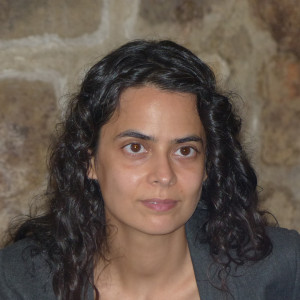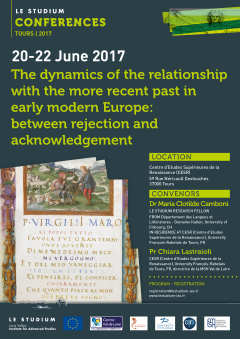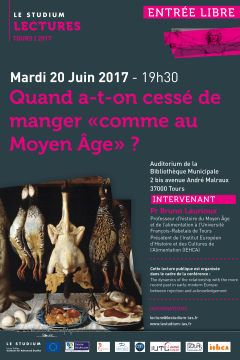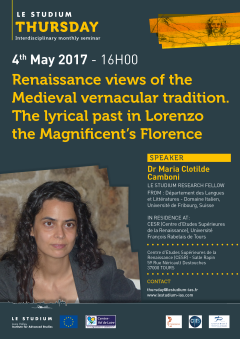Dr Maria Clotilde Camboni

From
Italian Language And Literature, University of Fribourg - CH
In residence at
Centre for Advanced Studies in the Renaissance (CESR) / CNRS, University of Tours - FR
Host scientist
Prof. Chiara Lastraioli
PROJECT
Middle Ages In Renaissance
The concepts of Middle Ages and Renaissance are strongly intertwined: it can be said that one cannot stand without the other. The idea of a revival of Classical antiquity, founding myth of the Renaissance created by the Renaissance itself, requires the existence of the “dark” Middle Ages, and their dismissal.
Nowadays, what was once the current idea of the Renaissance is under strong suspicion, and considered more a creation of some Italian authors than a valid label for a distinct historical and cultural period. Nevertheless, from a cultural viewpoint some historical differentiations can be traced, the main one being the affirmation of the idea of art as imitation of the Classics, especially in what is considered the culminating phase of the Italian Renaissance, the beginning of the XVI century.
Imitation of the Classics, but, from the second half of the XV century, and definitely from the XVI, also imitation of some medieval vernacular authors. Not being “Classics”, they are nevertheless chosen as models, and derogating from already established lexical uses, in few significant cases also referred to as “Ancients”.
The widening of the pool of available models in this direction could have resulted in eroding and finally invalidating the basis of the above-mentioned founding myth; yet the imitation of vernacular authors has been theorized by Pietro Bembo, who, sanctioning the possibility of taking as models some of them, also stated which ones, thus limiting the possible proliferation of the models.
The aim of the project is to investigate the context into which this selection process of the models unfolded, studying how medieval vernacular authors were considered before the turning point of Bembo’s codification. To accomplish its results, it will analyze the circulation of medieval vernacular literature into the most important literary environments of the Renaissance; its view by the principal treaties of the first three decades of the XVI century; and its presence into the literary works of selected authors.
Publications
This paper suggests a new interpretation of the tale of Lisabetta da Messina (Decameron IV 5) in the light of a fact which has thus far been disregarded by scholars: namely, that in both medieval culture, and its basis in Roman law, an individual cannot have more than one grave. In case of dismemberment, the burial place is considered to be the place where the head is interred. Therefore, the pot of basil in Boccaccio's tale is Lorenzo's tomb, and Lisabetta beheads her dead lover in order to be able to perform suitable funeral rites. Taking this into account, her behaviour as well as other aspects of the tale take on new meaning.
This article analyses the relationship of Pietro Bembo's Prose with the introductory Epistola of the Raccolta Aragonese and Cristoforo Landino's proemio to his Comento sopra la Comedia, with regard to their views of the previous vernacular tradition and in particular the more or less comparable paradigms applied to past literary history. The question of whether Bembo knew Poliziano's Epistola is investigated, and the similarities and dissimilarities between the different narratives concerning cultural development and the ways in which these narratives are elaborated in the three texts are evaluated.
Per collocare la sensibilità formale dei «due Guidi» all'interno del panorama duecentesco, occorre avere presente almeno a grandi linee quest'ultimo, e sarà quindi necessario in via preliminare darne conto 1. Anticipando le conclusioni, si può dire che il secondo Guido, Cavalcanti, è un caso particolare, una sorta di picco attorno a cui si addensano una serie di fenomeni riconducibili a una casistica che praticamente non si dà altrove. Al netto di ciò, per quel che riguarda la sensibilità metrica Guinizzelli e Cavalcanti si trovano sullo stesso versante, e la loro posizione condivisa sembra essere la logica conseguenza del fatto che appartenevano alla stessa classe sociale: quella dei milites 2. Il legame tra la maniera in cui i rimatori medievali si rappresentavano le forme da essi adottate e la loro posizione sociale ha le sue origini nel primo luogo di produzione e consumo di lirica cortese in volgare, le corti della Francia meridionale, dove notoriamente il pubblico veniva in contatto con i componimenti poetici in forme collettive, performative, sceniche, 1 Le ricerche che mi hanno portato a delineare la mappa di un panorama generale della sensibilità formale degli autori di lirica in Italia, dai poeti federiciani a Petrarca, sono state condotte grazie alla vincita della Fellowship Marco Praloran 2013-2015, e sono sfociate in un libro in questo momento in lavorazione presso la SISMEL (Camboni Maria Clotilde, Fine musica), a cui rimando per ulteriori approfondimenti. 2 Per il contesto sociale di Guinizzelli e Cavalcanti, cfr. da ultimo Milani Giuliano, Le contexte e Diacciati Silvia, Guido e i Cavalcanti.
Final reports
This project aimed at reassessing the views about the “Renaissance”, both by some leading representatives and in emblematic environments related to this cultural movement. The project reappraised their attitudes towards the Middle Ages, focusing on a critical, revealing cultural domain: the vernacular one. It investigated the context in which a selection of Medieval vernacular models were brought during the Italian Renaissance, testing the potential of the following three new interrelated approaches: 1. analysis of the late fifteenth-early sixteenth century tradition of medieval lyrical poems in connection with different perspectives on the poets transmitted through it; 2. comparative analysis of different relevant passages evaluating the medieval vernacular Italian tradition and proposing paradigms of historical development; 3. assessment of the effective influence on Renaissance poets of the early medieval lyrical authors/texts, taking into account the results of the above-mentioned analyses of the tradition of these texts.



